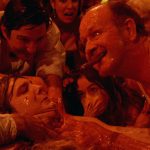
I had the great pleasure of chatting all things Vigilante Thriller with Dr James Newton, a lecturer in Media Studies, and a filmmaker, at The University of Kent (and author of the very good The Mad Max Effect). Check it out here

I had the great pleasure of chatting all things Vigilante Thriller with Dr James Newton, a lecturer in Media Studies, and a filmmaker, at The University of Kent (and author of the very good The Mad Max Effect). Check it out here
Released to a storm of controversy in Japan, Battle Royale, quickly developed a cult following in the West, no doubt helped by rumours that it was banned in the US (it wasn’t, but legal issues and censorship concerns kept it off screens for many years). A film that prompted questions in the Japanese parliament is now older than the competitors in the game it depicts. 
A new form of Battle Royale controversy, as seen in the moral panic regarding video games such as Fortnite and PUBG, has since surfaced and the old arguments about media effects has come back, spearheaded by President Trump among others, in the wake of more school shooting in the US. But what of the original film itself?
Battle Royale still retains the power to shock; it’s difficult not to watch open mouthed at times as a class of forty-two 15-16 year olds set about killing each other. That, of course, is a gross oversimplification of a film in which violence is used as a tool to critique the Japanese education system and their history of a martial culture. That many reviewers, and politicians, concentrated on the film’s violence when it was released only obfuscated the fact that it’s a much smarter film than it might first appear. Yes, it’s violent, but it’s also a film that probes the culture that produces such violence and never holds back from pointing fingers.
It would be easy to lump Battle Royale in with other violent films of the noughties, particularly the rise of torture porn, but that would be to denigrate a film that takes a real interest in its characters and draws from the director’s own experiences of the Second World War. Kinji Fukasaku, best known to Western audiences for his work on Tora, Tora, Tora (1970), took on the film at the age of 71, in part because it took him back to his work in a weapons factory when he was a teenager:
During the raids, even though we were friends working together, the only thing we would be thinking of was self-preservation. We would try to get behind each other or beneath dead bodies to avoid the bombs. When the raid was over, we didn’t really blame each other, but it made me understand about the limits of friendship (Rose 2001).
The limits of friendship are tested throughout as the students of class 3-B are each given a bag of supplies, a weapon, and 3 days to kill each other. Battle Royale takes place in a vaguely futuristic Japan where, after an economic crisis, youth is seen to be running wild. The government’s response, the BR Act, selects a single class from across the country (supposedly at random) and places them in a remote location. Only one of them is allowed to leave. To ensure their compliance each student is fitted with an explosive collar; if they step out of line or if more than one is alive at the deadline their throat explodes.
Although the film mostly follows the rather sweet couple of Shuya and Noriko, Fukasaku takes care to give as many of the students a sense of character as possible. This is expanded in the Special Edition in which the previously psychotic Mitsuko is given a back story that partly explains her character (an incredibly creepy sequence in which she is sold, as a little girl, by her mother to a paedophile whom Mitsuko then kills by accident). This emphasis on character shows a care for the students that lifts them from being cannon fodder. Some are resourceful, some are terrified, some are desperate to lose their virginity before death, but none are identical. It pushes back against the typical view of teenagers as a homogenous mass that threaten society. Indeed, the film clearly suggests that the teenagers are no worse than the culture that created them.
Shuya has been let down by his parents (an absent mother and a father who killed himself, Shuya finding the body), but he shows great resourcefulness and loyalty. Contrast him to the teacher Kitano (played by director ‘Beat’ Takeshi Kitano) who runs the Battle Royale – his life is in tatters: he is alienated from his wife and daughter, and has grown to hate his former class, and the young in general, for making him feel impotent (all except Noriko, for whom he has an unhealthy obsession). It’s a terrific performance by Kitano, which plays on his dual status as director of violent films and game-show host. He is almost impassive throughout only hinting at the inner frustrations his character is riven with, becoming so petty he refuses to share some cookies he swiped from Noriko with the military officers who run the “game”. 
Seen very much as a satire on the highly competitive Japanese education system on release the film exposes what happens when people are pitched against each other for crumbs. Of course, inevitably, the game is rigged with two ringers brought in to stack the deck against the students. Just like life, lip-service is paid to fairness, but the reality is far from it. When I first watched the film, when it was released in the UK in 2001, it seemed like a pretty dark and remote vision of how schools could become competitive production lines designed to stifle young-people and scare them into conforming. Having been in teaching for 12 years now it seems much less ridiculous. Reforms to the education system in England are leading to a rise in mental illness in students and one teacher’s comment that “I have at least one student who has attempted suicide, and others with a variety of mental health issues” (Busby) is becoming alarmingly typical, and something I’ve witnessed on a local level. This extends to UK universities where “the suicide rate among UK students had risen by 56 per cent in the 10 years between 2007 and 2016, from 6.6 to 10.3 per 100,000 people” (Rudgard).
An economic crisis followed by an increasingly cut-throat and competitive education system that pits young people against each other in which they are made to feel that their very lives are at stake? Battle Royale is now closer to reality than I find comfortable.
Works Cited
Busby, Eleanor (2018) Pupils self-harm and express suicidal feelings due to exam stress and school pressure, warn teachers. The Independent [online]. Available at https://www.independent.co.uk/news/education/education-news/school-pupil-mental-health-exams-school-pressure-national-education-union-neu-a8297366.html
Rose, Steve (2001) The Kid Killers. The Guardian [online]. Available at https://www.theguardian.com/film/2001/sep/07/artsfeatures2 [accessed 27/07/2018]
Rudgard, Olivia (2018) Universities have a suicide problem as students taking own lives overtakes general population. The Telegraph [online]. Available at https://www.telegraph.co.uk/news/2018/04/12/universities-have-suicide-problem-students-taking-lives-overtakes/ [accessed 27/07//2018]
This article was first published by Bright Lights Film Journal on January 16 2018 (http://brightlightsfilm.com/watch-it-again-society-brian-yuzna-1989/).
After nearly 30 years Society has become a perfect film for the age of Trump.
A withering satire on the American dream Yuzna’s film deserves to be rediscovered as one of the most odd, interesting and radical of American horrors. Hiding under the guise of a teen horror is an attack on the myth of the classless society, a (quite literal at times) peeling back of Reagan’s America in which growing inequality is dressed up in Hollywood gloss. Its message, that the rich operate a closed society in which they exploit the rest of America, has now become more relevant than ever.
As an outsider looking in America’s dedication to seeing itself as a classless society has often seemed a little absurd. From the UK, where class pretty much defines everything, the stratification of America in terms of class looks strangely familiar. Despite this a recurrent desire to define America as a society in which everyone is effectively middle class continues. Trump’s ascension is the story of man living off inherited wealth using rhetoric to de-class himself to appeal to disaffected, and often laid-off, manual workers. That this worked, despite the fact that he is exactly the type of asset stripper and outsourcer responsible for the economic status quo, demonstrates the power of myth in society. Whatever the particular niceties of Trump’s ability to make himself seem like a “regular guy” it’s a well-worn trope of American culture that he tapped into, one that turned against Hilary Clinton tainted, as she is, with the whiff of elitism.
This unwillingness to confront class divisions extends into American cinema, where the American dream is consistently reinforced and class is hardly ever a barrier for those who want to work hard. In many ways the Rocky franchise stands as the apotheosis of the myth of a culture in which everyone gets their shot at the title. Social mobility, we are repeatedly told, is available to all just as long as you work hard enough. The success of Stallone, and his 1980s rival Schwarzenegger, reinforced this myth as much as their films did – the self-created stars who through force of mind and body could transcend their poor origins to rise to the peak of Hollywood success.
For most, of course, this never happens. For every success there are numerous hard working people buying into the dream and never getting anywhere. In Society this exclusion from getting on is transformed into a world where the rich are not just different, they’re not human, and they literally feed off the poor.
Having made some waves in horror as producer of Re-Animator (Stuart Gordon, 1985) and From Beyond (Stuart Gordon, 1986), both based on Lovecraft and both employing body horror, Yuzna took a decidedly left turn with his directorial debut – it’s truly a film like no-other. Yes, it supplies the body horror, ably created in all its sticky glory by Japanese effects expert Screaming Mad George, but it fuses it with teen movie, conspiracy thriller and absurdist comedy in a way that would make Dr Herbert West proud.
 On the surface Society plays on recurrent adolescent fears of entering adulthood, especially in the realms of sexual relations. In many horror films, especially in the Slasher sub-genre, anxieties faced by the adolescent are dramatized; the killer, or monster, which must be conquered stands in for the desires/fears that need to be repressed for successful entry into the symbolic order. That the monster has a sexual ambiguity to it has been noted and extensively examined (particularly by Carol Clover). In many respects Society follows this formula as it centres on Billy Whitney (Billy Warlock[i]) a High School student. Billy is popular, has a cheerleader girlfriend, and has recently acquired a new Jeep Wrangler. However, and though he visits a re-assuring psychiatrist, a tape recording shared with him by a fellow student, Blanchard, reasserts Billy’s belief that there is something wrong with his family and their friends and, by extension, the wider high-class society he is part of but feels alienated from. Through various scenarios Billy’s paranoia develops until all is revealed – he is really a fatted calf, raised to be sacrificed in the Shunting, an orgy of twisted bodies where normal people are absorbed by the higher ups – judges, politicians and business leaders. It’s a hysterical sequence that paints the ruling class as sexual perverts who prolong their, possibly eternal, existence by draining life from the poor.
On the surface Society plays on recurrent adolescent fears of entering adulthood, especially in the realms of sexual relations. In many horror films, especially in the Slasher sub-genre, anxieties faced by the adolescent are dramatized; the killer, or monster, which must be conquered stands in for the desires/fears that need to be repressed for successful entry into the symbolic order. That the monster has a sexual ambiguity to it has been noted and extensively examined (particularly by Carol Clover). In many respects Society follows this formula as it centres on Billy Whitney (Billy Warlock[i]) a High School student. Billy is popular, has a cheerleader girlfriend, and has recently acquired a new Jeep Wrangler. However, and though he visits a re-assuring psychiatrist, a tape recording shared with him by a fellow student, Blanchard, reasserts Billy’s belief that there is something wrong with his family and their friends and, by extension, the wider high-class society he is part of but feels alienated from. Through various scenarios Billy’s paranoia develops until all is revealed – he is really a fatted calf, raised to be sacrificed in the Shunting, an orgy of twisted bodies where normal people are absorbed by the higher ups – judges, politicians and business leaders. It’s a hysterical sequence that paints the ruling class as sexual perverts who prolong their, possibly eternal, existence by draining life from the poor.
Under the guise of a teen horror Yuzna manages to twist familiar genre tropes in service of his political message. The high class setting immediately sets Society apart from other teen horrors of the era as it eschews the everyday nature of most where-in, such as in A Nightmare on Elm Street (Wes Craven, 1984) and Halloween (John Carpenter, 1978), the main characters are located in a ‘regular’ neighbourhood, remarkable only in its interchangeableness with those in other teen horrors or in the isolated teen-spaces such as the camp, as in Friday the 13th (Sean S. Cunningham, 1980). Society is also different in having a male protagonist rather than the final-girl that features in most, if not all, 1980s teen horrors – a male teen idol who, for many, could stand in for wholesome values. Society plays a subversive game with genre, moving the familiar context to one which appears aspirational, and tied to mainstream ideas of success. The Whitney household is a Beverley Hills mansion, pristine and white, overtly displaying the wealth and advantages Billy expects to inherit – however his alienation from this lifestyle is evident from the beginning and is also encapsulated in his appearance: dark-haired when the rest of the family are blonde, shorter than his sister and school colleagues (he is literally looked down on by this ideal, Aryan, family). “They don’t even look like me” he tells Dr Cleveland, but the difference also suggests a paranoia that the film plays on, editing being used to undermine Billy’s gaze, replacing disturbing images with those that are more normal and asking the audience to question the reality placed before them.
 The opening of the film foregrounds this willingness to be subversive and to blur boundaries between reality and fantasy. A typical dream sequence occurs in which Billy, clutching the classic slasher weapon of the kitchen knife, walks scared through his own house, only to be confronted by his mother all the while a female voice sings a haunting rendition of the Eton Boating Song (reminiscent of the use of nursery rhymes in the Elm Street series and tying the film to old-world class structures). The film cuts to the psychiatrist’s office where Billy confides his feelings of fear and dread to Dr Cleveland. Billy takes an apple and bites, revealing worms within. It’s an obvious but still potent symbol of the corruption under the skin in this supposed Eden. Then, adding another surreal layer, it cuts to a flash-forward of the Shunting, allowing us to see merged body parts, covered in a sticky fluid with muted moans as the Eton Boating Song Resumes with a new re-written lyric;
The opening of the film foregrounds this willingness to be subversive and to blur boundaries between reality and fantasy. A typical dream sequence occurs in which Billy, clutching the classic slasher weapon of the kitchen knife, walks scared through his own house, only to be confronted by his mother all the while a female voice sings a haunting rendition of the Eton Boating Song (reminiscent of the use of nursery rhymes in the Elm Street series and tying the film to old-world class structures). The film cuts to the psychiatrist’s office where Billy confides his feelings of fear and dread to Dr Cleveland. Billy takes an apple and bites, revealing worms within. It’s an obvious but still potent symbol of the corruption under the skin in this supposed Eden. Then, adding another surreal layer, it cuts to a flash-forward of the Shunting, allowing us to see merged body parts, covered in a sticky fluid with muted moans as the Eton Boating Song Resumes with a new re-written lyric;
Oh how we all get richer
Playing the rolling game
Only the poor get poorer
We feed off them all the same
Then we’ll all sing together
To society we’ll be true
Then we’ll all sing together
Society waits for you
This layering is disconcerting in its denial of familiar tropes and the missing context for the images. Billy we can presume is the protagonist, but his circumstances straddle an umheimlich situation, wealth familiar from various soap-operas, commercials and glossy magazines, juxtaposed with paranoia, anxiety and mutated bodies. The lighting and Dutch-angle of the opening sequence situate the film firmly in the horror genre, but the following shots disturb the reassurance any generic recognition might bring.
Society also takes the metaphorical desires and problems of other teen-horrors clear and makes them obvious. Halloween, in its first person prologue, hints at incestual desire as Michael Myers kills his half-naked older sister immediately after she has had sex with her boyfriend. Society deliberately places Billy’s sister Jenny as a figure of desire, both for Billy and the spectator, in a scene where she showers. However as it foregrounds this desire, it simultaneously undermines and perverts it by suggesting an unnatural and impossible configuration of body parts; Jenny’s torso appears twisted so that both her breasts and buttocks appear through the frosted glass. This highlights one issue, the amorphous bodies of the Shunters, and also implies an incestual element to the gaze. In Elm Street the sins of the parents, in their killing of child murderer Freddy Kruger, is played out on the bodies of the teenagers while their parents exist in incompetent denial. In Society the parents are the sin, a secret hidden in plain sight, their bodies the site of perversion and horror.
The fluidity of the human body on display in Society differentiates it from earlier examples in the genre and is indicative of contemporary sexual politics, especially in light of the aids crisis during the 1980s. The Shunting sequence sees body parts swap place and people intertwine. Yuzna uses some of this for humour, Billy dad becoming a literal “Butt-head”, and some to push boundaries linked to sexual hysteria: the incest between Jenny and her mother, the gay kiss between Ferguson and Billy. Most pertinent is the emphasis on penetrability of the human body, especially the penetrative potential of the male anus, through which both Blanchard and Ferguson are killed. The merging of the human bodies that occur during the Shunting evokes the female body in several ways, not only in the representation of penetrability. Through a perverse eroticism is evident in Society, finding its apotheosis in the Shunting. Both objects of Billy’s desire, his sister and eventual love Clarissa, twist their bodies at the waist. The anus again becomes visible and accessible to the male. This homo-erotic anxiety pervades then throughout the film, initially played out on the bodies of women, then seen more obviously during the Shunting. It is Billy’s ability to avoid penetration, and his penetrating of Ferguson, that allows him to escape. This subverts his class role (as member of the under-class) but disavows the homo-sexual eroticism from earlier in the text.

The sexual anxieties that run through the film connect directly to the class rules of American society in which the majority are encouraged to live sexually “normal” lives of heterosexual monogamy. The upper orders are free to indulge their perversities safe in the knowledge that the Police will protect them, rounding Billy up in the film. Access to the higher sections of American society is prohibited too, Billy losing his High School election despite being the most popular student in School (which also costs him his girlfriend). All his entitlements are stripped away from him in the film as it becomes clear he is not one of “them”, his dream-life crumbling. Rounded up by the authorities Billy, and us, witness the Shunting, an orgy organised in honour of a Judge and attended by various figures from Washington in which Blanchard is drained of his nutrients. Finally Billy realises that he is adrift in a society he cannot enter and one that sees him as food, his paranoia is real – Society is designed to work against him. The end of the film leaves the status quo intact, the powers that support are to large to simply be undone by one man.
A flop on release in America (two years after production) Society found an audience in Europe where class divisions are more openly acknowledged. It deserves to be rediscovered in modern America as a radical departure from genre norms, but also as one the most searing critiques of the American Dream.
Works Cited
Clover, Carol (1993) Men, Women and Chainsaws: Gender in the Modern Horror Film. London: BFI Publishing.
[i] Warlock’s casting adds an intertextual meaning due to his role in The Days of Our Lives preceding Society. The long running soap-opera features the aspirational life-style satirized in Society.
A discussion about Brian Yuzna’s Society
http://brightlightsfilm.com/watch-it-again-society-brian-yuzna-1989/#.Wl5zNNGnyhA
On its release Pauline Kael described Sam Peckinpah’s Straw Dogs (1971) as;
the first American film that is a fascist work of art[i]
and Richard Schickel called it “unrelenting evil”[ii]. A collection of thirteen British film critics went so far as to write a letter to The Times describing their disgust at the BBFC’s decision to release the film, citing the depiction of “double rape and multiple killings by a variety of hideous methods”[iii]. Several local councils in Britain took the step of banning the film[iv] and the VHS was caught up in the video nasty panic of the 1980s (withdrawn from home viewing in 1988 the film saw the light of day, uncut, on DVD in the UK in 2002)[v]. It was not only the depiction of the violence, both sexual and non-sexual, that produced such a reaction, but also the sense that the film was giving out a simplistic message about the nature of masculinity – that the film suggests that violence is essential to manhood and that the female character, Amy played by Susan George, is simply reduced to an object to be fought over by the men (she was also seen to embody the myth that all women want to be raped). Although these reactions are not without justification mostly the ambiguity of the film was missed, especially in relation to the representation and motivation of the central character David Sumner (played by Dustin Hoffman). Hoffman’s character is so objectionable, remaining ignorant of his wife’s emotional state (and her rape), that the simplicity of the conclusion that the film, and thus the film-makers, approve of his actions is found wanting. Indeed Peckinpah’s use of a montage aesthetic to present the film violence, especially in the concentration on reaction shots further queries the meanings of the violent scenes. David’s final abandonment of Amy and the home he has fought to protect, coupled with his protection of Niles the mentally impaired murderer, further complicate a simplistic reading.
Beyond the discussion of violence and gender (which is taken up extensively by Stephen Prince in Savage Cinema) lies an intriguing inability to place Straw Dogs securely in any category. The general critical concentration of Straw Dogs as an auteur work has obfuscated its generic position. Indeed Straw Dogs is a film that defies simple genre categorisation and one wonders how much of the critical reaction was linked to this inability to securely define the film. The anxieties about violence are prevalent in much criticism of the time and would be used to critique Peckinpah both before and after 1971, however violence being such an essential part of the Western genre (especially the ritualised gun-fight) mitigates, to some extent, its use elsewhere in his films.
Beyond the violence debate Straw Dogs stands as an interesting nexus of several generic concerns present in popular American cinema during the late 1960s and early 70s. We can see this time as one of transition where many genres were being reconceived. The Western of course comes to mind, particularly in Peckinpah’s own films but also in others such as Little Big Man (Arthur Penn, 1970). Film Noir would be re-evaluated in Chinatown (Roman Polanski, 1974) and The Long Goodbye (Robert Altman, 1973), and Bonnie and Clyde (Penn, 1968) had already married the gangster film with a nouvelle vague aesthetic. Straw Dogs does stand as a revisionist Western, taking one of the classic Western scenarios, the protestant captivity narrative, displacing it to Cornwall and transferring it to the modern age but it also offers a deconstruction of the concept of the classic Western/American heroic ideal. David Sumner begins as the opposite of this, he is a man running from his troubles and unwilling to use violence as a solution to problems. Indeed David avoids conflict of any sort until the final scene where his intellectual pose is finally shorn and his inner capacity for violence is revealed. The supressed American male emerges. Reaction to Vietnam and the demographic and social shifts in America also run through David Sumner’s abandonment of America, and a strong questioning of America’s relationship with the rest of the world is evident. Although David is subjected to xenophobic taunting by the locals, so his inability to communicate to them as anything other than an American (such as pointedly ordering American cigarettes in the local pub) reflects his self-righteous attitude.
Beyond the Western there is a link to the British horror tradition, such as the pastoral horror of Witchfinder General (Mathew Hopkins, 1968), which would be followed by The Wicker Man (Robin Hardy, 1973), where small communities are shown to be hiding a darker underside. It prefigures the rape-revenge cycle most obviously seen in I Spit on Your Grave (Meir Zarchi, 1978). The film also fulfils many of the criteria evident in the American horror film of the time – the rural scenario in which city dwellers are forced to confront the wild and rabid locals. Examples such as Deliverance (John Boorman, 1972), The Texas Chainsaw Massacre (Tobe Hooper, 1974) and The Hills Have Eyes (Wes Craven, 1977) compare well. The Heddon family in Straw Dogs, motherless and with a suggestion of incestuousness in the daughter Janice, links to the corrupt families presented in these later films.
The breaking down of domestic relations by a traumatic event followed by a spiral into violence is repeated in Last House on the Left (Wes Craven, 1972). The vigilante theme, running through the final siege, links to two other 1971 releases, The French Connection (William Friedkin) and Dirty Harry (Don Siegel), but also later to Death Wish (Michael Winner, 1974) and Taxi Driver (Martin Scorsese, 1976). There is of course the question of “ultra-violence” which inevitably leads to comparisons with A Clockwork Orange (Stanley Kubrick, 1971). The contradictions in the reactions between the use of violence in Straw Dogs and A Clockwork Orange were extensively noted in a Screen article by Charles Barr linking critical reaction to the filmmaking technique;
The final irony is that the same critics who were so sternly against violence in reviewing Straw Dogs are now found not only enjoying it (in its safely ‘distanced’ form) but intellectually endorsing it[vi]
[i] Kael, Pauline (1971) “Peckinpah’s Obsession”, Deeper into Movies: the Essential Collection from 1969 to 1972. London: Marion Boyars Publishers Ltd
[ii] Schickel, Richard (1972) “Don’t Play it Again, Sam”, Life Magazine, February 11th, 1972
[iii] Cashin, F, et al (1971) “Film Censorship”, The Times, 17th December 1971
[iv] Barr, Charles (1972) “Straw Dogs, A Clockwork Orange and the Critics”, Screen, Summer 1972, Volume 3, Number 2
[v] www.sbbfc.co.uk/case_study_strawdogs.asp
[vi] Barr, Charles (1972) “Straw Dogs, A Clockwork Orange and the Critics”, Screen, Summer 1972, Volume 3, Number 2